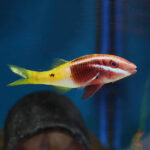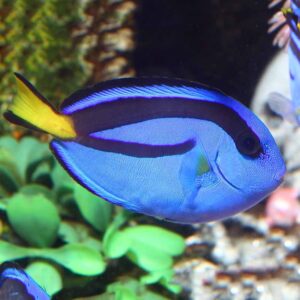Description
Yellow Frogfish (Antennarius spp.) are small-sized fish that can reach a maximum size of around 3 to 4 inches (7.5 to 10 cm) in length. They have a stocky and compressed body with a large head. The colouration of yellow frogfish varies among species but typically includes shades of yellow, orange, or brown, often with mottled or spotted patterns. They have a unique and distinctive appearance, with their modified pectoral fins resembling “arms” and a large mouth filled with sharp teeth.
Taxonomy:
Yellow frogfish belong to the genus Antennarius, which is part of the family Antennariidae. The genus Antennarius includes numerous species of frogfish known for their peculiar appearance and hunting strategies.
Natural Habitat:
Yellow frogfish are found in various tropical and subtropical regions worldwide, inhabiting coral reefs, rocky areas, and seagrass beds. They have a benthic lifestyle and are typically found resting on the substrate or using their modified fins to “walk” along the ocean floor. Their habitat provides them with ample opportunities to camouflage and ambush their prey.
Keeping Yellow Frogfish Healthy:
Yellow frogfish require expert care and are considered challenging to keep in captivity. They have specific habitat and feeding requirements that must be met to ensure their well-being. Maintaining water quality is crucial, including appropriate temperature, salinity, and pH levels. Regular monitoring and adjustments may be necessary. Due to their delicate nature, they are prone to stress and are highly susceptible to diseases, making it essential to provide a stress-free environment and quarantine new additions.
Special Requirements and Feeding:
Yellow frogfish have unique feeding requirements as they are voracious carnivores. They feed primarily on small fish, crustaceans, and other invertebrates. Live or frozen foods such as shrimp, fish, and squid should be provided to meet their dietary needs. Offering a varied diet is important for their health and growth.
How Many Should I Keep:
It is recommended to keep only one yellow frogfish per tank due to their aggressive and territorial nature. Keeping multiple frogfish together can lead to aggression and potential cannibalism.
Lighting Preference:
Yellow frogfish prefer low to moderate lighting conditions in their aquarium. They are naturally adapted to dimly lit environments, and excessive lighting can cause stress.
Suitable Tank Mates:
Yellow frogfish are not suitable for reef tanks or community setups as they are highly predatory and may prey on smaller tank mates. It is best to house them alone or with other compatible species that are too large to be considered prey.
Reproduction in the Wild:
Yellow frogfish reproduce through internal fertilization. Males have a specialized organ called a “clasper” that is used to transfer sperm to the female during mating. The female then releases eggs, which are fertilized externally. The eggs are typically large and sticky, allowing them to adhere to various surfaces in the environment until they hatch into tiny larvae.
Breeding Antennarius spp:
- Set up:
Breeding yellow frogfish in captivity requires careful planning and preparation. A separate breeding tank should be set up with suitable hiding places and ample space for the pair to swim and spawn. The water parameters, including temperature, salinity, and pH, should be maintained at optimal levels.
- Courtship/Spawning:
Courtship in yellow frogfish involves elaborate displays by the male to attract the female. The male may change coloration and exhibit fin movements to signal his readiness to mate. Once courtship is successful, the male clasps the female’s abdomen with his specialized organ called a “clasper” to transfer sperm.
- Rearing:
After successful fertilization, the female yellow frogfish releases adhesive eggs. These eggs are typically laid on a substrate or attached to plants or other surfaces in the breeding tank. The parents do not provide any parental care, so it is crucial to monitor the eggs closely to ensure their well-being. The eggs will hatch into tiny larvae, which will require specialized care and feeding.
Sexual Dimorphism
Sexual dimorphism in yellow frogfish is relatively subtle. In some species, females may be slightly larger than males, but the differences are not significant. The most reliable way to determine the sex of a yellow frogfish is through behavioural cues during courtship and spawning.
Distribution
Yellow frogfish are naturally distributed in the Indo-Pacific, the Red Sea, and the Caribbean Sea.
Summary
Yellow frogfish, belonging to the genus Antennarius, are fascinating and unique fish known for their distinctive appearance and predatory behaviour. They require expert care and are best suited for experienced aquarists. Breeding these fish in captivity requires a separate breeding tank, proper courtship, and suitable rearing conditions. Sexual dimorphism is minimal, and the fish are naturally distributed in tropical and subtropical regions. Yellow frogfish are captivating and challenging additions to a well-maintained aquarium.
The Fish pictured here are representative only and the livestock you receive may vary in pattern, coloration, and shape.









Reviews
There are no reviews yet.